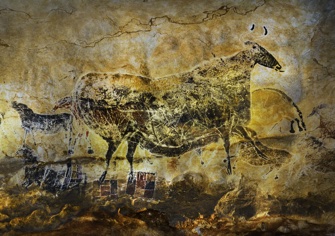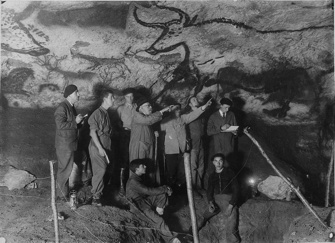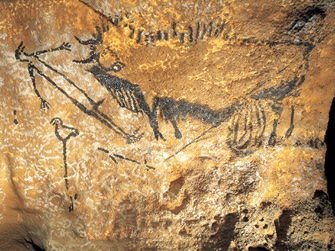Cro-Magnon Cave Art
Pays a Visit to Paris

“The Black Cow.” Photo © Denis Nidos
I have never had the opportunity to visit the original Lascaux caves (closed to the public since 1963 because of the damage to the wall paintings inadvertently caused by visitors), but I have been to Lascaux 2, a “facsimile” of the temple of rock painting located near the original cave, which turned out to be surprisingly convincing.
The experience of seeing this replica of the paintings and engravings created by Cro-Magnons some 20,000 years ago was so impressive and moving that when I heard that an exhibition called “Lascaux à Paris,” which similarly replicated parts of the Lascaux caves, was being held in Paris, I was determined to see it even though I feared it might be one of those hokey commercial traveling exhibitions that pop up in town from time to time (in fact, the show was created by the department of the Dordogne, where Lascaux is located).
I wasn’t encouraged when it seemed like I had to walk miles to reach the very last building in the sprawling Porte de Vetsailles convention complex on the edge of Paris to finally arrive in a stuffy, non-air-conditioned space with black walls.
There was no question of turning back after all that effort, however, so I plunged into the exhibition with my audio guide glued to my ear. I don’t normally use them, but the wall texts were so brief that I thought I might learn more by listening in.
In the first part of the exhibition, a series of displays explains the history of the cave, which was discovered in 1940 by an 18-year-old boy whose dog fell into a hole in the ground one day. He went back with a group of friends, widened the hole and descended into what turned out to be a Paleolithic wonderland.
This section of the show also goes into the archaeological explorations of the cave, its

A visit to the cave shortly after it was discovered in 1940. Photo © CNP-MCC-DRAC
opening to the public and subsequent closure, and the development of Lascaux 2.
All fine and good, but I was more interested in seeing the replicas of the paintings themselves. Happily, on that very hot day, this part of the exhibition was air-conditioned.
Five sections of the cave have been reproduced. They are presented in two types of light: at the levels likely to have been provided by the oil lamps used by those who painted them, and under a blue light that makes the underlying engravings visible. The oil lamps, by the way, were simple limestome bowls with handles in which they burned reindeer fat, a long-lasting fuel.
Unfortunately these fragments do not reproduce the magical immersive experience of Lascaux 2, even though it, too, is a replica. I also found it frustrating that the brief explanations noted that there were different interpretations for each panel without mentioning what the various possibilities were.
Four well-executed life-sized and purportedly realistic sculptures representing Cro-Magnons, also on display this room, show that they were very little different from modern-day humans and that they wore sophisticated clothing and accessories, including jewelry.
The next part of the show goes into more detail, using interactive video screens that clearly and simply explain some of the theories about the panels, one of which shows the only depiction of a human in Lascaux, alongside the only representations of a rhinoceros and a bird. The drawing of the human is little more than a stick figure of a man with an erection and

The only human figure found in the cave, facing an injured bison. © Conseil Départemental de la Dordogne
a bird’s head facing a bison whose entrails are falling out, presumably after being struck by a hunter’s spear. Below him is a bird that seems to be impaled on a long stick, and behind him is a rhinoceros, which was apparently painted at a different time. The theory is that these out-of-the-ordinary images, which are found in a difficult-to-access part of the cave, may have been painted by shamans, but their meaning is still unclear.
The most complex of the reproduced panels is the “Panel of the Black Cow” (pictured at the top of this page). Behind the large beast, whose feet touch a series of symbolic squares (once again, meaning unknown), is a row of galloping horses, which are more fully visible under the blue light. All in all, Lascaux has 915 animal figures and 500 mysterious hieroglyphic-like symbols: parallel lines, squares, rectangles, and other shapes that variously look like bows and stalks of wheat (my interpretation) but as to whose meaning no expert yet ventures a definitive opinion.
A film shown in its own cave-like space in the exhibition analyzes each of the five panels in an enlightening way, showing, for example, how the talented Lascaux artists depicted movement with multiple images, and is well worth watching. Many of the exhibits in this part of the show were designed with children in mind, and those who were there when I was did indeed seem to be fascinated by them.
The show ends with audio commentary by a number of experts on the cave, followed by an interesting look at the lifestyle of Cro-Magnon man in the region: their teepee-like dwellings; fairly sophisticated tools, including sewing needles; clothing and jewelry; and diet, mostly reindeer meat, supplemented by fish, birds, eggs and berries.
In the end, the show was worth seeing, although it only provides a foretaste of what you might see in Lascaux 2. I recommend that you go there, as well as to the Caverne du Pont d’Arc, the recently opened replica of the more recently discovered and even older (36,000 years) Chauvet-Pont-d’Arc Cave in the Ardêche. Was the potential competition from it the stimulus for this exhibition vaunting the merits of Lascaux? No matter, both are surely worth the trip.
Lascaux à Paris: ParisExpo, Porte de Versailles, Pavillon 8/B. 1, place de la Porte de Versailles, 75015 Paris. Métro: Porte de Versailles. Tel.: 0 892 68 36 22. Open daily 10am-7pm. Admission: €15.90 (€12.90 on Mondays). www.lascauxaparis.com
Reader reaction: Click here to respond to this article (your response may be published on this page and is subject to editing).
Please support Paris Update by ordering books from Paris Update’s Amazon store at no extra cost. Click on your preferred Amazon location: U.K., France, U.S.
More reviews of Paris art shows.
© 2015 Paris Update
Favorite